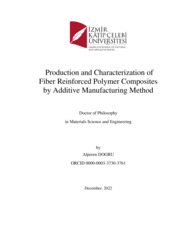Production and Characterization of Fiber Reinforced Polymer Composites by Additive Manufacturing Method
-
Eser Sahibi
ALPEREN DOĞRU
- Tez Danışmanı MEHMET ÖZGÜR SEYDİBEYOĞLU
-
Tür
Doktora Tezi
- Yayın Tarihi 2022
-
Yayıncı
Fen Bilimleri Enstitüsü
- Tek Biçim Adres https://hdl.handle.net/11469/3255
-
Konu Başlıkları
Hybrid Composites
Polymeric Composites
Polyamide
Nanocellulose
Fused Filament Fabrication
Additive Manufacturing
Polimer malzemelerin eklemeli imalat teknolojisiyle üretilmesi günümüzde eğilim olan önemli bir konudur. Eklemeli imalat yöntemi ile yüksek performanslı polimer ürünlerin üretilmesi konusunda çalışmalar yapılmaktadır. Mevcut durumda eklemeli imalat yöntemlerinden erimiş filaman ekstrüzyonu (FFF) yönteminde çok çeşitli polimerler işlenebilmektedir. FFF yönteminde genel olarak saf polimerler tercih edilmektedir FFF yönteminde kullanılan bazı polimerler düşük mekanik özellikler göstermekte, mühendislik alanındaki uygulamaları kısıtlamaktadır. Yüksek performanslı polimerlerin üretilmesi ise oldukça pahalı ve erime sıcaklıklarının yüksek olması sebebiyle FFF ile işlenmesi zordur. Bu sebeple saf polimerlerin mukavemet özelliklerini iyileştirmek amacıyla kısa lif takviyesi yapılmıştır. FFF yönteminde üretim gerçekleştirebilmek için tez çalışmasında kısa lif katkılı polimer matrisli filamentler geliştirilmiştir. Geniş uygulama alanı, üstün mekanik, termal ve kimyasal özellikleri sebebiyle poliamide matris malzemesi olarak belirlenmiştir. Geliştirilen filamanlar pahalı ve işlenmesi zor malzemelerin yerini alabilecek, standart FFF cihazları ile kolay işlenebilen ürün geliştirilecek ve test edilebilir ürünlerin üretilmesi sağlanacaktır. Bu alanda kullanılan malzeme çeşitliliğinin artması FFF yöntemi ile üretilmiş ürünlerin endüstriyel kullanım alanını arttırılacak ve kompozit yapıların plastik enjeksiyon, vakum infüzyon veya basınçlı kalıplama olmaksızın imal edilmesi sağlanacaktır. Lif takviyeli polimer filamanlar ile havacılık, savunma, otomotiv ve medikal sektörleri başta olmak üzere kompleks geometrili ürünlerin düşük maliyetli olarak üretilmesine imkan sağlanacaktır. vi Lif takviyeli polimer kompozit filamanların FFF yöntemi ile üretilmesinde karşılaşılan en önemli problem, katmanların yeterli birleşmemesi ve mikro ara yüzeylerin oluşmasıdır. Bu kusurların giderilmesi bu yöntem ile üretilen nihai ürünlerin mekanik performanslarını arttıracaktır. Bu kapsamda tez çalışmalarının ilk aşamalarından karbon, cam ve hibrit (karbon/cam) fiber takviyeleri poliamide 6 matrisli filamanlar geliştirilmiş, numune üretimleri ve karakterizasyonlar yapılmıştır. FFF yöntemi ile farklı üretim parametrelerinin mekanik özellikleri incelenmiş ve proses parametreleri optimize edilmiştir. İkinci aşamada ise matris-fiber ara yüzeylerini iyileştirmek ve mekanik özelliklerini arttırmak amacıyla cam ve karbon fiberlere nanoselüloz katkısı gerçekleştirilecektir. Modifiye edilmiş fiberler kullanılarak aynı filamentler geliştirilmiş, FFF yöntemi ile numune üretimi gerçekleştirilip karakterizasyonlar yapılmıştır. Geliştirilen hibrit kompozit yapılar yenilikçi bir yaklaşım olup maksimum çekme mukavemeti değerlerinde saf PA6’ya oranla 3 katı artış sağlanmıştır.
The production of polymer materials with additive manufacturing technology is an
important issue that is a trend today. Studies are carried out on the production of highperformance polymer products with the additive manufacturing method. Currently, a
wide variety of polymers can be processed in the Fused Filament Fabrication (FFF)
method, one of the additive manufacturing methods. Pure polymers are generally
preferred in the FFF method. Some polymers used in the FFF method show low
mechanical properties, limiting their applications in the field of engineering. Highperformance polymers are expensive to produce and difficult to process with FFF due
to their high melting temperatures. For this reason, short fiber reinforcement was used
to pure polymers' strength properties. To carry out production in the FFF method, short
fiber-reinforced polymer matrix filaments were designed in the thesis study.
Polyamide has been determined as a matrix material due to its wide application area
and superior mechanical, thermal, and chemical properties. Designed filaments will be
able to replace expensive and difficult-to-process materials, products that can be easily
processed with standard FFF devices will be designed and testable products will be
produced. The increase in the variety of materials used in this field will increase the
iv
industrial usage area of the products produced by the FFF method and it will be
possible to manufacture composite structures without injection molding, vacuum
infusion, or pressure molding. With fiber-reinforced polymer filaments, it will be
possible to produce low-cost products with complex geometries, especially in the
aerospace, defense, automotive, and medical industries.
The most important problem in the production of fiber-reinforced polymer composites
by the FFF method is the insufficient bonding of the layers and the formation of micro
interfaces. Elimination of these defects will increase the mechanical performance of
the final products produced by this method. In this context, carbon, glass, hybrid
(carbon/glass) fiber reinforcements, and polyamide 6 matrix filaments were designed
from the first stages of the thesis studies, and specimen production and
characterizations were made. The mechanical properties of different production
parameters examined with the FFF method process parameters were optimized. In the
second stage, nanocellulose was added to glass and carbon fibers to improve the
matrix-fiber interfaces and increase their mechanical properties. The same filaments
were produced using modified fibers, and specimen production with the FFF method
and characterizations were made. The designed hybrid composite structures are an
innovative approach and their maximum tensile strength values are increased by 3
times compared to pure PA6.
-
Koleksiyonlar
ENSTİTÜLER
FEN BİLİMLERİ ENSTİTÜSÜ

 Tam Metin
Tam Metin

